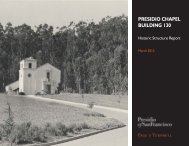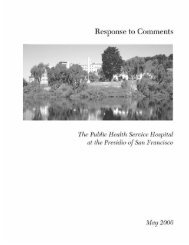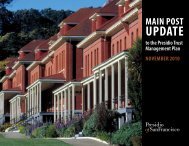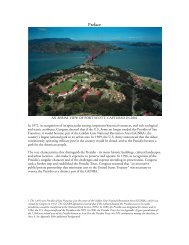Water Quality Report - 2010 - Presidio Trust
Water Quality Report - 2010 - Presidio Trust
Water Quality Report - 2010 - Presidio Trust
Create successful ePaper yourself
Turn your PDF publications into a flip-book with our unique Google optimized e-Paper software.
<strong>2010</strong> ANNUAL<br />
WATER QUALITY REPORT<br />
PRESIDIO OF SAN FRANCISCO<br />
Lobos Creek in use at Rob Hill Campground.<br />
The <strong>Presidio</strong> <strong>Water</strong> Treatment plant vigilantly safeguards its water supplies. Last year, <strong>Presidio</strong> tap water<br />
met all U.S. Environmental Protection Agency and State drinking water health standards. This report details<br />
where your water comes from and how its quality is measured.<br />
(Este informe contiene informacion muy importante sobre su agua beber. Traduzcalo o hable con alguien que<br />
lo entienda bien.)
THE PRESIDIO WATER SUPPLY<br />
The <strong>Presidio</strong> gets its water from two sources.<br />
Seventy to eighty percent is drawn from the <strong>Presidio</strong>’s<br />
Lobos Creek, the last free-flowing natural stream in<br />
San Francisco. The remainder is purchased from the<br />
San Francisco <strong>Water</strong> Department. This water is drawn<br />
from the Hetch Hetchy <strong>Water</strong>shed, the Alameda<br />
County <strong>Water</strong>shed, and the Peninsula <strong>Water</strong>shed.<br />
LOBOS CREEK<br />
Most of the <strong>Presidio</strong>’s potable water needs are met by<br />
a local surface water source, Lobos Creek, which runs<br />
along the <strong>Presidio</strong>’s southwest corner. Daily flows in<br />
<strong>2010</strong> averaged 1.4 million gallons per day. The <strong>Presidio</strong><br />
<strong>Water</strong> Treatment Plant draws from the flow of Lobos<br />
Creek, treats the water, and distributes it park-wide to<br />
over 1,000 service connections.<br />
To ensure healthy water, the <strong>Presidio</strong> <strong>Trust</strong> implements<br />
a <strong>Water</strong> <strong>Quality</strong> Management Plan that includes<br />
procedures to detect and remedy any potential sources<br />
of contaminants. The <strong>Trust</strong> also has a sampling program<br />
that requires quarterly Volatile Organic<br />
Compounds (VOC) testing. Additionally, the <strong>Trust</strong><br />
monitors the trend of Tetrachloroethylene (PCE) levels<br />
in Lobos Creek (for complete results, see tables<br />
beginning p. 4). Raw samples are taken from Lobos<br />
Creek; treated samples are taken from the main reservoir.<br />
A source water assessment (entitled the <strong>Water</strong>shed<br />
Sanitary Survey) of Lobos Creek was last updated in<br />
November 2006; a copy is available in the <strong>Presidio</strong><br />
<strong>Trust</strong> Library, 34 Graham Street, in the <strong>Presidio</strong>.<br />
Lobos Creek sample analysis results have detected low<br />
levels (.6 to .8 parts per billion) of Tetrachloroethylene<br />
(PCE) from dry cleaning establishments located<br />
throughout the neighboring Richmond District of San<br />
Francisco. However, treated samples from the drinking<br />
water supply have not detected any PCE. Lobos Creek<br />
also contains detectable levels of nitrate that may come<br />
from leaks in the San Francisco combined sewer/storm<br />
system but the nitrate level has never exceeded the<br />
Maximum Contaminant Level (MCL).<br />
The Richmond Transport System, a combined storm<br />
and sanitary waste collection system that crosses<br />
beneath the creek near 25th Avenue and Lincoln<br />
Boulevard, is a Potential Contaminant Activity (PCA).<br />
However, the Richmond Transport System is beneath<br />
the creek and rarely flows full. Two other possible<br />
PCAs include a former military missile site and a landfill,<br />
both located northeast of the creek. These sites are<br />
part of the <strong>Presidio</strong> <strong>Trust</strong> remediation program, and<br />
extensive monitoring of these sites will continue to<br />
ensure groundwater and surface water sources remain<br />
protected and safe.<br />
Other PCAs with a high impact ranking are gas stations,<br />
landfills, chemical storage, metal fabrication, and<br />
plastics producers. Though these types of activities<br />
exist within the watershed boundary, there is no evidence<br />
that they contaminate the water supply.<br />
SAN FRANCISCO WATER DEPARTMENT<br />
Hetch Hetchy Reservoir is located in the Sierra region<br />
and meets all federal and state criteria for watershed<br />
protection. Based on the San Francisco Public Utilities<br />
Commission (SFPUC) disinfection treatment practice,<br />
extensive bacteriological-quality monitoring, and high<br />
operational standards, the State has granted the Hetch<br />
Hetchy water source a filtration exemption because<br />
the source meets filtration avoidance criteria. In other<br />
words, the source is so clean and protected that the<br />
SFPUC is not required to filter water from the Hetch<br />
Hetchy Reservoir.<br />
The Hetch Hetchy water is supplemented with surface<br />
water from two local watersheds. Rainfall and runoff<br />
collected from Alameda <strong>Water</strong>shed, which spans more<br />
than 35,000 acres in Alameda and Santa Clara<br />
Counties, are collected in the Calaveras and San<br />
Antonio Reservoirs. Prior to distribution, the water<br />
from these reservoirs is treated at the Sunol Valley<br />
<strong>Water</strong> Treatment Plant (SVWTP). Treatment processes<br />
include coagulation, flocculation, sedimentation, filtration,<br />
and disinfection.<br />
PAGE 2 | <strong>2010</strong> ANNUAL WATER QUALITY REPORT
....PRESIDIO WATER SUPPLY CONTINUED<br />
Fluoridation, chloramination and corrosion control<br />
treatment are provided for the combined Hetch<br />
Hetchy and SVWTP water at the Sunol<br />
Chloramination and Fluoridation Facilities. Rainfall<br />
and runoff captured in the 23,000-acre Peninsula<br />
<strong>Water</strong>shed, located in San Mateo County, are stored in<br />
four reservoirs: Crystal Springs (Lower and Upper),<br />
San Andreas, Pilarcitos, and Stone Dam. The water<br />
from these reservoirs is treated at the Harry Tracy<br />
<strong>Water</strong> Treatment Plant (HTWTP). Treatment processes<br />
at the HTWTP include ozonation, coagulation, flocculation,<br />
filtration, disinfection, fluoridation, corrosion<br />
control treatment, and chloramination.<br />
A copy of the complete SFPUC <strong>2010</strong> assessment is<br />
available at the San Francisco district office of the<br />
California Department of Public Health. Request a<br />
copy by calling (510) 620-3474.<br />
QUESTIONS<br />
If you have questions about this report or <strong>Presidio</strong><br />
drinking water, please contact Jody Sanford in the<br />
<strong>Presidio</strong> <strong>Trust</strong> Public Affairs Office at (415) 561-5418.<br />
To learn about drinking water regulations, visit the<br />
California Department of Public Health at<br />
www.cdph.ca.gov or the U.S. Environmental<br />
Protection Agency at www.epa.gov/safewater/.<br />
San Francisco water policy issues are decided at the<br />
San Francisco Public Utilities Commission hearings,<br />
held the second and fourth Tuesdays of each month<br />
at 1:30 pm at San Francisco City Hall, Room 400<br />
(visit www.sfwater.org). For information about <strong>Presidio</strong><br />
<strong>Trust</strong> public meetings, call (415) 561-5418.<br />
THE PRESIDIO COMMUNITY<br />
Located on the tip of the San<br />
Francisco peninsula, the <strong>Presidio</strong><br />
was in constant use as a military<br />
post from 1776 to 1994. Today, it<br />
is a National Historic Landmark<br />
District and a distinct part of the<br />
Golden Gate National Recreation<br />
Area, the largest urban national<br />
park in the United States. People<br />
live and work in the <strong>Presidio</strong> as<br />
well as visit, making this a unique<br />
public park. The community is<br />
comprised of approximately 2,700<br />
residents, 4,000 employees, and<br />
thousands of visitors. Their activities<br />
depend upon a healthy drinking<br />
water system.<br />
Lobos Creek Valley<br />
In <strong>2010</strong>, a new scenic overlook was constructed, offering dramatic views<br />
of Lobos Creek Valley, site of the <strong>Presidio</strong>’s primary water supply and<br />
ongoing environmental restoration work.<br />
<strong>2010</strong> ANNUAL WATER QUALITY REPORT | PAGE 3
WHY TEST DRINKING WATER<br />
The <strong>Presidio</strong> <strong>Trust</strong> conducts extensive testing of the park’s water supplies and<br />
distribution system to ensure that the <strong>Presidio</strong>’s drinking water is safe and<br />
healthy. In all cases, <strong>Presidio</strong> drinking water meets or exceeds the standards<br />
set by Federal and State health protection agencies. The State allows us to<br />
monitor for some contaminants less than once per year because concentrations<br />
of these contaminants do not change frequently. Some of our data,<br />
though representative, are more than one year old.<br />
The sources of drinking water (both tap water and bottled water) include<br />
rivers, lakes, streams, ponds, reservoirs, springs, and wells. As water travels<br />
over the surface of the land or through the ground, it dissolves naturally<br />
occurring minerals and, in some cases, radioactive material, and can pick up<br />
substances resulting from the presence of animals or from human activity.<br />
Such substances are called contaminants. Drinking water, including bottled<br />
water, may reasonably be expected to contain at least small amounts of some<br />
contaminants. The presence of contaminants does not necessarily indicate<br />
that water poses a health risk.<br />
In order to ensure that tap water is safe to drink, the U.S. Environmental<br />
Protection Agency (USEPA) and the California Department of Public Health<br />
(CDPH) prescribe regulations that limit the amount of certain contaminants<br />
in water provided by public water systems. CDPH regulations also establish<br />
limits for contaminants in bottled water that must provide the same protection<br />
for public health.<br />
Contaminants that may be present in source water include:<br />
• Microbial contaminants, such as viruses and bacteria, that may come from<br />
sewage treatment plants, septic systems, agricultural livestock operations, and<br />
wildlife.<br />
• Inorganic contaminants, such as salts and metals, that can be naturally-occurring<br />
or result from urban stormwater runoff, industrial or domestic wastewater<br />
discharges, oil and gas production, mining, or farming.<br />
• Pesticides and herbicides that may come from a variety of sources such as<br />
agriculture, urban stormwater runoff, and residential uses.<br />
• Organic chemical contaminants, including synthetic and volatile organic<br />
chemicals, that are by-products of industrial processes and petroleum production,<br />
and can also come from gas stations, urban stormwater runoff, agricultural<br />
application, and septic systems.<br />
• Radioactive contaminants that can be naturally occurring or be the result of<br />
oil and gas production and mining activities.<br />
More information about contaminants and potential health effects can<br />
be obtained by calling the USEPA’s Safe Drinking <strong>Water</strong> Hotline<br />
(800) 426-4791.<br />
Iron and Manganese<br />
We routinely detect high levels of minerals, iron and manganese (see analyses)<br />
in Lobos Creek. However, treated water testing results were well below<br />
the Secondary MCL. Iron and manganese are secondary constituents that<br />
affect the aesthetic quality of water (i.e. taste, color and odor), but do not<br />
pose a health threat. Manganese has a tendency to discolor water.<br />
W A T E R Q U A L I T Y D A T A<br />
These tables list all drinking water contaminants detected in the <strong>Presidio</strong> in <strong>2010</strong>.<br />
<strong>Presidio</strong> drinking water met or surpassed all state and federal water quality requirements.<br />
TABLE 1: INDIVIDUAL TAP MONITORING FOR LEAD AND COPPER<br />
Monitoring of individual taps from locations within the water system is performed every three years and was last performed in June <strong>2010</strong> to verify that the delivered water does not contain lead or copper<br />
at levels that may have negative health effects. The next round of tests is scheduled for June 2013.<br />
This table summarizes the most recent monitoring for these constituents. No site exceeded the regulatory action level.<br />
NO. OF SAMPLES 90TH PERCENTILE<br />
LEVEL DETECTED<br />
ACTION LEVEL MCLG TYPICAL SOURCE<br />
Lead (ppb) 10 2.0 15 2 Corrosion of plumbing systems<br />
Copper (ppm) 10 .190 1.3 .017 Corrosion of plumbing systems<br />
If present, elevated levels of lead can cause serious health problems, especially for pregnant women and young children. Lead in drinking water is primarily from materials and components associated with<br />
service lines and home plumbing. The <strong>Presidio</strong> <strong>Water</strong> Treatment Plant is responsible for providing high quality drinking water, but cannot control the variety of materials used in plumbing components. When<br />
your water has been sitting for several hours, you can minimize the potential for lead exposure by flushing your tap for 30 seconds to 2 minutes before using water for drinking or cooking. If you are concerned<br />
about lead in your water, you may wish to have your water tested. Information on lead in drinking water, testing methods, and steps you can take to minimize exposure is available from the Safe<br />
Drinking <strong>Water</strong> Hotline or at http://www.epa.gov/safewater/lead.<br />
TABLE 2: DISTRIBUTION SYSTEM MICROBIOLOGICAL SUMMARY<br />
One detection of coliform in 2009.<br />
MICROBIOLOGICAL<br />
CONTAMINANTS<br />
HIGHEST NO. OF<br />
DETECTIONS<br />
MCL MCLG TYPICAL SOURCE OF BACTERIA<br />
Total Coliform 0 More than one sample in a month with a detection 0 Naturall present in the environment<br />
Fecal Coliform or E. coli 0 A routine sample and a repeat sample detect total coliform and<br />
either sample also detects fecal coliform or E. coli<br />
TABLE 3: DETECTION OF CONTAMINANTS WITH A PRIMARY DRINKING WATER STANDARD<br />
CHEMICAL OR CONSTITUENT<br />
(REPORTING UNITS)<br />
SAMPLE<br />
DATE<br />
LEVEL<br />
DETECTED<br />
RANGE OF<br />
DETECTIONS<br />
MCL<br />
PHG<br />
(MCLG)<br />
0 Human and animal fecal waste<br />
TYPICAL SOURCE OF CONTAMINANT<br />
Nitrate (ppm) <strong>2010</strong> 37 36-37 45 45 Erosion of natural deposits, Soil run-off<br />
PCE (ppb) <strong>2010</strong> .8 .6 - .8 5 0 Leaching from PVC pipes, discharge from factories,<br />
dry cleaners and auto shops (metal degreaser)<br />
Nitrate in drinking water at levels above 45 ppm is a health risk for infants of less than six months of age. Such nitrate levels in drinking water can interfere with the capacity of the infant’s blood to carry<br />
oxygen, resulting in a serious illness; symptoms include shortness of breath and blueness of the skin. Nitrate levels above 45 ppm may also affect the ability of the blood to carry oxygen in other individuals,<br />
such as pregnant women and those with specific enzyme deficiencies. If you are caring for an infant, or you are pregnant, you should ask advice from your health care provider.<br />
The PCE results are from Lobos Creek. Treated water samples show no detection of PCE.<br />
TABLE 4: SAMPLING RESULTS SHOWING TREATMENT OF SURFACE WATER SOURCES<br />
TREATMENT TECHNIQUE*<br />
CONVENTIONAL FILTRATION<br />
Turbidity Performance Standards**<br />
Turbidity of the filtered water must:<br />
1 - Be less than or equal to 0.5 NTU in 95% of measurements in a month.<br />
2 - Not to exceed one NTU for more than eight consecutive hours.<br />
3 - Not to exceed five NTU at any time<br />
Lowest monthly % of samples that met Turbidity Performance Standard No. 1 100%<br />
Highest single turbidity measurement during the year<br />
.07 NTU<br />
The number of violations of any surface water treatment requirements<br />
None<br />
* A required process intended to reduce the level of a contaminant in drinking water<br />
** Turbidity (measured in NTU) is a measurement of the cloudiness of water and is a good indicator of water quality and filtration performance. Turbidity results that meet performance standards are considered to be in compliance<br />
with filtration requirements.<br />
SAN FRANCISCO TREATED WATER:<br />
Turbidity – Harry Tracy Treatment Plant <strong>2010</strong>
...WATER QUALITY DATA<br />
CONTINUED<br />
TABLE 5:<br />
SECONDARY STANDARDS<br />
No MCLG for secondary constituents. Typical source of contaminant for the following is run off/leaching from natural deposits.<br />
PRESIDIO WATER<br />
SAN FRANCISCO WATER<br />
DATE OF<br />
TEST<br />
LEVEL<br />
DETECTED<br />
SECONDARY<br />
MCL<br />
DATE OF<br />
TEST<br />
RANGE<br />
AVERAGE<br />
SECONDARY<br />
MCL<br />
Hardness <strong>2010</strong> 228 ppm none set<br />
Sodium <strong>2010</strong> 34 ppm none set<br />
Sulfate <strong>2010</strong> 40 ppm 250 ppm<br />
Iron <strong>2010</strong> 169 ppb 300 ppb<br />
Manganese <strong>2010</strong> 39 ppb 50 ppb<br />
Chloride <strong>2010</strong> 46 ppm 500 ppm<br />
Color <strong>2010</strong> 14 units 15 units<br />
Conductivity <strong>2010</strong> 613 uS/cm 1600 uS/cm<br />
TDS <strong>2010</strong> 333 ppm 1000 ppm<br />
Hardness <strong>2010</strong> 8-104 53 ppm none set<br />
Sodium <strong>2010</strong> 3-22 13 ppm none set<br />
Sulfate <strong>2010</strong> 1-39 18 ppm 500 ppm<br />
Iron <strong>2010</strong> not reported not reported 300 ppb<br />
Manganese <strong>2010</strong> .3-9 4.6 ppm 50 ppb<br />
Chloride <strong>2010</strong> 3-16 10 ppm 500 ppm<br />
Color <strong>2010</strong> not reported not reported not reported<br />
Conductivity <strong>2010</strong> 33-316 179 uS/cm 1600 uS/cm<br />
TDS <strong>2010</strong> 27-174 95 ppm 1000 ppm<br />
Periodically, your water may appear yellowish-brown. If you<br />
experience this, let your water run for several minutes or<br />
until the color goes away. If the problem persists, please call<br />
the <strong>Water</strong> Treatment Plant at (415) 561-4134.<br />
Radiological <strong>Water</strong> <strong>Quality</strong><br />
Results of most recent test for radiological constituents:<br />
Below MCL: All. Date: 2006. Next round of radiological<br />
sampling is in 2012.<br />
Disinfection and Fluoridation<br />
The <strong>Presidio</strong> <strong>Water</strong> Treatment Plant used chloramines as a<br />
disinfectant in <strong>2010</strong>. The San Francisco <strong>Water</strong> Department<br />
used chloramines. Chloramines are a combination of chlorine<br />
and ammonia. Chloramines are disinfectants that are<br />
believed to reduce potentially harmful by-products of chlorine<br />
alone. Chloramines may be toxic to some pet fish and<br />
kidney dialysis patients. <strong>Water</strong> used at the <strong>Presidio</strong> is fluoridated.<br />
Fluoride concentrations are required to stay within a<br />
control range of .9 - 1.5 ppm for the <strong>Presidio</strong>. The average<br />
for the year <strong>2010</strong> was 1.1 ppm.<br />
Cryptosporidium<br />
In <strong>2010</strong>, the <strong>Presidio</strong> water department sampled Lobos<br />
Creek and detected Cryptosporidium. The <strong>Presidio</strong> was<br />
required to sample Lobos Creek two times per month from<br />
April <strong>2010</strong> to March 2011. Based on the results of all samples,<br />
the <strong>Presidio</strong> will be evaluated by the California<br />
Department of Public Health to determine if any additional<br />
treatment is required.<br />
Cryptosporidium is a microbial pathogen found in surface<br />
water throughout the United States. Although filtration<br />
removes Cryptosporidium, the most commonly-used filtration<br />
methods cannot guarantee 100 percent removal.<br />
<strong>Presidio</strong> monitoring indicates the presence of these organisms<br />
in our source water. Current test methods do not allow<br />
us to determine if the organisms are dead or if they are<br />
capable of causing disease. Ingestion of Cryptosporidium<br />
may cause cryptosporidiosis, an abdominal infection.<br />
Symptoms of infection include nausea, diarrhea, and<br />
abdominal cramps. Most healthy individuals can overcome<br />
the disease within a few weeks. However, immuno-compromised<br />
people, infants and small children, and the elderly are<br />
at greater risk of developing life-threatening illness. We<br />
encourage immuno-compromised individuals to consult<br />
their doctor regarding appropriate precautions to take to<br />
avoid infection. Cryptosporidium must be ingested to cause<br />
disease, and it may be spread through means other than<br />
drinking water.<br />
Special Needs<br />
Some people may be more vulnerable to contaminants in<br />
drinking water than the general population. Immuno-compromised<br />
persons such as those with cancer undergoing<br />
chemotherapy, persons who have undergone organ transplants,<br />
people with HIV/AIDS or other immune system disorders,<br />
some elderly people, and infants can be particularly<br />
at risk from infections. These people should seek advice<br />
about drinking water from their health care providers.<br />
USEPA/Centers for Disease Control (CDC) guidelines on<br />
appropriate means to lessen the risk of infection by<br />
Cryptosporidium and other microbial contaminants are<br />
available from the Safe Drinking <strong>Water</strong> Hotline at (1-800-<br />
426-4791) or at www.epa.gov/safewater.<br />
PAGE 6 | <strong>2010</strong> ANNUAL WATER QUALITY REPORT















